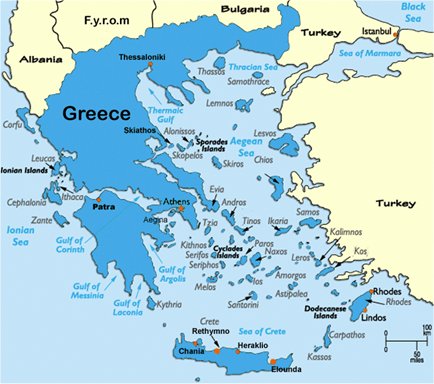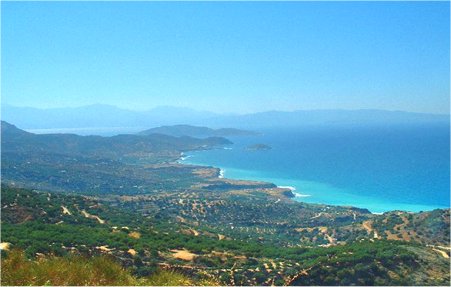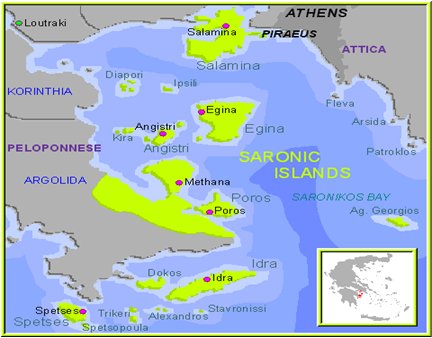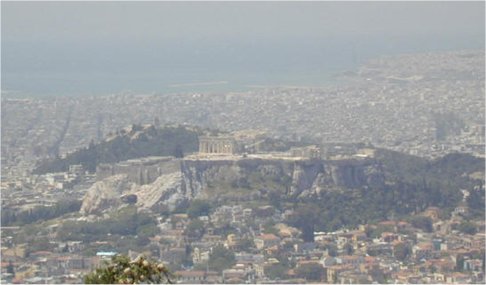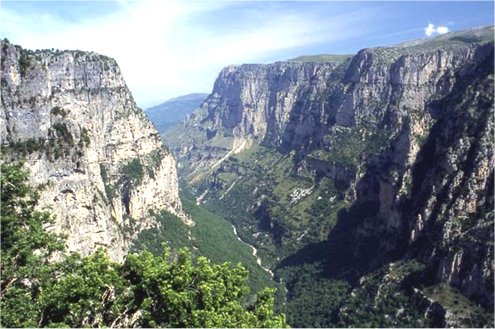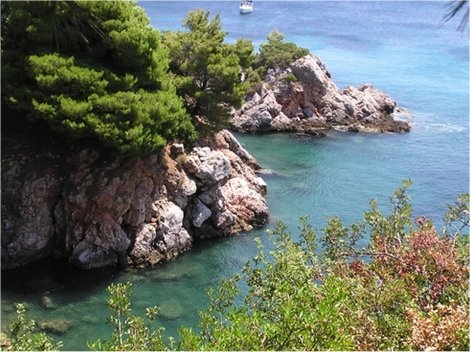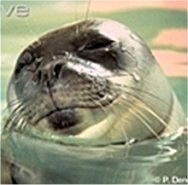|
March 18, 2011
The Most Important and Urgent Environmental Problems in Greece in the Last Decade (2000-2010)
Athanasios Valavanidis and Thomais Vlachogianni
Department of Chemistry, University of Athens, University Campus Zografou, 15784 Athens, Greece
Abstract A comprehensive state of the Greek environment in the last decade is presented in this review as well as the most important and urgent environmental issues. Greece's major efforts in the last decades to achieve economic convergence with the other European Union countries and material prosperity for its citizens, resulted in the neglect of the environmental impact by tourism, construction, intensive agriculture, industrial development and rapid urbanization. Greece's environment faces some major environmental challenges, such as air emissions from transport and electricity power stations, overexploitation of its water resources, water pollution, degradation of its coastal zones, loss of biodiversity in terrestrial and marine ecosystems and increasing municipal and industrial waste. In the last decade major problems of management, funding and implementation of policies with strict environmental regulations have appeared in every aspect of environmental protection. Limited enforcement of environmental laws and practices and giving in to various demands of organized local interests has been the Achilles' heel of policy implementation. This situation resulted in the lack of clear strategies for the major environmental problems and the necessity for environmental reforms in many areas. Although funding and environmental taxes have been a major problem for Greece, corruption and malpractices by local authorities, private citizens and state institutions is another important issue. It is hoped that EU regulations and international obligations will force consultation and encouragement of public participation, as well as education and environmental information that will increase public awareness. This overview covers air and water pollution, coastal areas, biodiversity, national parks and protected areas, municipal ad hazardous waste, energy generation, emissions of greenhouse gases, environmental education. Only selected bibliographical references are used and some important national and international report on the environmental performance of Greece in the last decade.
Keywords: Environment Greece; Air and water pollution; Biodiversity protected areas; Coastal areas; Municipal waste; Environmental education
Introduction. Greece and the state of the environment An overview of the state of the environment in Greece in the mid 1990s (air, water, soil, nature conservation, marine environment and noise) was published in 1994 in this journal (Katsoulis and Tsangaris 1994). providing a broad-based assessment of the environmental situation in the 1990s. In the last 20 years, Greece has been undergoing major economic and social developments as a full member of the European Union (EU). But Greece's major efforts towards economic and social convergence to other European countries have been partially matched by environmental control of various forms of pollution and improving the quality of life. In the field of environmental legislation and regulations Although Greece has made much progress in the last ten years, administrative incompetence, corruption and local authoritiesΒ inactivity to take concrete actions for environmental law enforcement have been the AchillesΒ heel of policy implementation. Rapid economic growth and rising income levels in the last decade increased pressures on the environment. Changes in such major sectors as industry, energy, agriculture, transport, tourism, construction of houses and roads, urbanization and development of coastal areas, strongly influenced environmental pollution and degradation of natural resources. These fast changes diminished the benefits of environmental policies, technological progress and investment in environmental infrastructure. Although Greece has still untouched natural environment and rich cultural heritage, recent developments of economic growth put increased environmental pressures. Especially from unplanned urbanization and expansive housing construction in forested areas and coastal zones (islands). Also, resulted in increased air emissions for electricity generation and excessive use of water (OECD 2009). Greek agriculture has experienced significant changes with profound impact on the state of the environment (excessive use of water for irrigation, soil erosion, nitrate and phosphate pollution of rivers and lakes). In the last decade water quality has been undermined severely Although urban air quality has greatly improved in big cities, such as Athens, Thessaloniki and Patras, as a result of better fuel quality, promotion of public transport and less polluting private cars, levels of some air pollutants remain above regulated levels. Nationwide measures have improved energy efficiency, but high demand makes the task very difficult. Particulate air pollution in cities and in areas with power stations and industries remains very high. Investment efforts on air pollution abatement and control has been low. The recent use of natural gas for industrial and household power generation is expected to improve air pollution (Beopoulos and Skuras 2008). Legislation of nature conservation and the establishment of protected areas was advanced at a slow pace and only recently management bodies were established. Efforts have been made in recent years to protect marine and forest ecosystems, as well as sensitive coastal areas. Municipal and toxic industrial waste increased substantially, illegal waste tips are still exist in many areas due to local resistance to allocate organized waste facilities. The integration of environmental concerns in economic, industrial, agricultural and social policies in order to achieve cost-effective environmental protection and sustainable development is facing slow progress at a time that Greece's rapid growth demands urgent and drastic actions. Public awareness, information and education about environmental protection are changing. But enforcement of national legislation is often too slow or lacking, because of weak co-operation among ministries and agencies, and lack of rigorous inspection and prosecution which are impeded by low numbers of environmental inspectors (National Center for the Environment and Sustainable Development, 2008). The influence of the European UnionΒs directives on environmental protection and the substantial funding from the EU on Greece's political decisions on policy and development have been to some extend beneficial, but the strategic national objectives on environmental protection priorities and sustainable development remain unsolved to a great extend. In recent years it became obvious that Greece needs a comprehensive national strategic plan for the environment, based on wide consultation and setting specific objectives, targets and priorities. The new Ministry of the Environment, Energy and Climatic Change that was formed for the first time in 2009 (before it was Ministry for the Environment, Physical Planning and Public Works) it is hoped to promote the solutions of various urgent pollution problems and reverse chronic environmental issues. The recent economic crisis and the dramatic financial problems Greece is experiencing at present will probably postpone some measures for environmental protection.
Physical geography and demographics of Greece
Greece is located in the southern end of the Balkan Peninsula, bordering the Ionian, Aegean and the Mediterranean Seas. Greece has a total area of 131,940 km2 with a population of 11.26 millions (2008, Eurostat). The country consists of a large mainland and an archipelagos of around 3,000 islands. Greece has 18,000 km of coastline and is by 80% mountainous with the highest peak of 2,919 m in Olympus. Greece has three different types of climate: a Mediterranean climate (mild, wet winders and hot dry summers), an Alpine climate (Western-North Greece), and a temperate climate with cold, damp winders and hot, dry summers. Inevitably it has a rich and varied fauna and flora. Wildlife consists of bears, wolfs, wild boars, snakes, vultures, eagles and a large number of birds. The variation of plants and trees on Greece is exceptional with over 6000 species, mostly indigenous. Marine life is also exceptionally varied with some rare and endemic species. More than 75% of the population live in urban areas. Athens and the surrounding urban area has a population 4.5 million and Thessaloniki city in the north with 1 million population. Piraeus is the biggest and most busy port in the country (20 million passengers and 1.5 million containers per year). Recently, there is a decreasing trend of the annual and seasonal levels of precipitation, especially the summer precipitation which is projected to decrease for the Mediterranean region. These trends are expected to affect fauna and flora, biodiversity, water resources, forest fires and various sensitive ecosystems.
Aquatic environment: water resources and aquatic pollutionGreece is endowed with adequate water resources but their uneven distribution makes sustainable use and protection from pollution a very difficult task. Greece has a great variety of lagoons and wetlands, a long coastline with rocky and sandy beaches and thousands of small and large islands, uninhabited islets and reefs surfacing throughout the Aegean and Ionian Seas. A typical example of contested and conflicting uses of freshwater resources in Greece is the ongoing dispute for the Acheloos water transfer project. The plan was to irrigate the Thessaly plain after construction in the Acheloos river of four major dams and reservoirs, a 17.4 km long diversion channel and two tunnels. The aim is to divert 600 million cubic meters of water annually. The dispute continues for 20 years with bitter legal battles between the state and nongovernmental environmental organizations (NGOs) to stop it. The plans have changed to a small scale and the construction continues. Freshwater. The most important problem is the excessive use of freshwater for agricultural irrigation and to a lesser extent through leakage in household distribution. Freshwater quantity problems have been dealt with increasing storage capacities through reservoirs and water transfer schemes. Despite the greater awareness of water use and its ecological importance, the domestic and industrial sectors are not water efficient. The Greek government is reluctant to introduce drastic abstraction charges, pricing mechanisms and restrictions in the agricultural sector for sustainable water use (Tsouni et al. 2002). Overloading with nitrogen fertilizers, nitrates, pesticides, phosphorous and organic discharges from urban and agricultural wastewater are the main pollutants of rivers, lakes and wetlands in Greece. Pollution of groundwater is another serious environmental problem. The quality of surface waters in the mainland is in general terms satisfactory, but some lakes and rivers show the effects of widespread pollution owing to eutrophication, agricultural pollution (liquid waste of livestock farming, fertilizers and pesticides) and household and industrial liquid and solid waste. Implementation of EU legislation and funds in the last 20 years have been decisive in developing municipal waste water infrastructure in all major towns and cities and waste water treatment plants have been established in most industrial areas (National Center of Environment and Sustainable Development 2008; Voutsa et al. 2001). Greece has around 30 natural and 12 artificial lakes and the quality of their waters varies widely. Surface freshwater in the Pindus region and throughout Epirus (northwest Greece) are considered very clean. Some lakes such as Vestonis, Vegoritis, Ag. Vasilisos (Koronia), Doirani, Kastoria, and Pamvotis are having pollution problems due to anthropogenic activity in the form of fertilizers, pesticides, heavy metals, organic matter and untreated sewage (Konstantinou et al. 2006). Water quality assessment in the major rivers of Greece, such as Aliakmon, Axios, Gallikos, Loudias, Strymon (northern Greece) and Kosynthos (north-eastern Greece) as well streams and tributaries were contacted in recent years for heavy metals. Exceedences were observed for Mn, Fe, Cu, Cr, Cd and Pb in some cases (Karageorgis et al. 2003; Simeonov et al. 2003; Mattas et al. Pisinaras et al. 2007). Drinking water. Drinking water monitoring in Greece is conducted at regular intervals. Monitoring of drinking water from nine regions of Greece showed a variety of pollutants and heavy metals. Levels of Pb exceeded the regulate limit of 10 μg⋅L-1 in most regions. Attica prefecture proved to have very good quality of water. The majority of problematic drinking water were concentrated in the Cyclades islands where there is scarcity of water resources. Quality in other regions was related to the conditions of the water supply networks (Karavoltsos et al. 2008). Six sampling periods with 15 sampling sites were organized in 2006-2007 for the drinking water reservoirs of Athens and Attica (Yliki, Mornos and Marathon man-made reservoirs by the Athens Water Supply and Sewerage Company) for 13 heavy metals and metalloids. All concentrations were below the regulated levels (Farmaki 2007).
ThessalonikiΒs drinking water was studied for nitrate, arsenic and chloride pollution in 2003. Tap water samples were collected from 52 villages of the Prefecture of Thessaloniki. Nitrate concentrations from two specific regions were much higher than the permitted level. A number of samples (13.5%) contained As above the limit of EU drinking water (10 ppb). The majority of samples from seashore areas had increased concentrations of chloride ions due to seawater intrusion in the aquifers (Fytianos and Christophoridis 2004). Coastal and marine environment. Greece is surrounded by sea and with a coastline of 18000 km has many and difficult coastal and marine environmental problems. Around 30% of the Greek coastline is affected by erosion which threatens vulnerable coastal ecosystems and protected areas. Despite national protection actions in recent years, marine pollution by discharges of ship fuel, industrial and municipal waste, overexploitation of living marine resources and coastal loss of marine habitat still prevail in many areas. The rapid expansion of tourism and urbanization (roads, houses and hotels) in coastal areas threatens marine and coastal degradation. Sewage remains the largest source of pollution. Marine and coastal eutrophication from elevated nitrogen and phosphorous inputs is a worrying trend and has occurred in several enclosed bays (Ministry for the Environment, Physical Planning, and Public Works 2006). Recent studies of the marine waters and environmental conditions in Greece became more systematic and extensive. Studies expanded to physiological and ecological levels of the marine flora and fauna. The most important challenges of marine environmental research is the increasing pollution of the seas and the funding of the costly environmental projects. This research was supported by the Hellenic Centre for Marine Research (HCMR) and various university departments in Greece (Haritonidis 1995; Hellenic Centre for Marine Research 2005). The Saronikos Gulf has been the centre for research and monitoring for many years because of the untreated sewage pollution discharged from the metropolitan Athens and Piraeus areas and the shipping pollution of the port. Before, the effect of sewage effluent (calculated at 600-750,000 m3 per day) on the benthos of the Saronikos was catastrophic from pollutants, such as hydrocarbons, sediments, heavy metals and PAHs. The most vulnerable area is the Elefsis Bay and other areas near and around the port of Piraeus. When finally the Psyttalia wastewater treatment plant (1994-1999 with biological treatment plant) started operating the situation in the Gulf changed and the conditions have improved substantially (Makra et al. 2001; Scoullos et al. 2007; Vlahogianni et al. 2007; Valavanidis et al. 2008). The Thermaikos Gulf is a semi-enclosed bay close to the city of Thessaloniki with severe pollution problems. The Gulf receives the waters of four major rivers (Aliakmon, Loudia, Axios and Gallikos) and as a result it is enrinched with organic carbon, nutrients and particulate matter. Nutrient concentrations are very high at the mouths of the rivers. As a consequence, red tides and phytoplankton blooms have been observed and anoxic conditions during the summer period near the harbor. Also, the Gulf is polluted by sewage and industrial effluents. A new wastewater treatment plant has improved the situation in the last few years (Sklivagou and Georgakopoulou 2000).
Greece has also many other coastal marine areas and semi-enclosed bays with various environmental problems, mainly from stock farming sewage, agricultural effluents, municipal and industrial waste. Several initiatives have been undertaken in the last decade by the Ministry for the Environment with the financial assistance of the EU. The Envireg Programme, co-financed by the Greek government focused on the reduction of coastal pollution and protection of coastal biotopes. Also, the National Programme for the Environment assisted by regional activities dealt with water quality and pollution in coastal areas The programme Life-Nature for coastal areas deals with management problems semi-closed areas, such as the Amvrakikos bay, and lagoons of Tsoukalio, Asvieri, Rodia and Logarou, the Messolongi wetland, conservation programmes for the Ionian sea regions concerning habitats and threatened species. Also, the Greek environmental authorities participate in the activities of the Barcelona Convention and the Mediterranean Action Plan (Ministry for the Environment, Physical Planning and Public Works 2006; Ministry for the Environment, Energy and Climatic Change 2010). Bathing water. Greece has some of the best bathing water quality (Blue flags) in Europe. Every year there are more than 2.000 sampling points and 25.000 monitoring samples. Greece reported eight parameters under the Directive 76/160/EEC (total coliforms, faecal coliforms, faecal streptococci, mineral oils, etc). In 2009, a total of 2.107 bathing waters were reported in Greece of which 2.101 were coastal bathing waters and six freshwater bathing waters on lakes. 60% of the coastal bathing waters met the mandatory values. This is a high decrease of 39% compared to the previous year. The mandatory water quality was met in 98% of the bathing waters since 1996 and since 2001 in over 99% of the bathing waters. Also, 66% of the freshwater bathing waters were in compliance with the mandatory values and the more stringed guide values in 2009. (European Environment Agency. Bathing water results 2009-Greece, 2010). Marine alien fauna of Greek waters The number of biological invasions of the marine environment has grown dramatically in recent decades, causing serious ecological and economic impacts. The Mediterranean Sea is subject to the ever-increasing arrival of non-indigenous marine organisms. The numbers of alien marine species recorded in the Greek marine environment increased to 110 (2007). The last species are zoobenthic and zooplanktonic species and teleost fish (Zenetos et al. 2007). Fisheries. The intense exploitation and depletion of fisheries stocks in Greece's seas is a fact. In the past fisheries issues were considered almost in economic and political terms. Today fisheries activities are recognized as environmental problems in the broader sense (Hellenic Center for Marine Research 2008). Water pollution, the European Court and the EUGreece was referred numerous times to the European Court of Justice for failing to respect the EU directives or to put in place adequate measures to protect the water environment. Two typical examples are presented. In January 2000 the European Commission DG XI decided to make an application for non-respect of the EU nitrates Directive. The Greek case was related to the failure to adopt codes of good agricultural practices and action programmes. Also, Greece's monitoring programmes for fresh waters were insufficient (EU, Directorate General XI 2000). In May 2010 the European Commission pursued legal proceedings against Greece for failing to put in place adequate measures to protect one of Europe's most important wetlands. The case relates to the pollution and degradation of Lake Koronia in the region of Thessaloniki. Greece is being sent a second and final written warning for failing to implement the necessary legal protection and conservation framework for the site (European Commission 2010)
Atmospheric Pollution in Greece The main sectors and activities driving air pollution in Western Europe and in Greece in the past three decades have been energy, transport, industry, agriculture, solvent use and storage and distribution of fossil fuels. Although economic recession in the early 1990s was a driver in the decrease of air pollution by industry, the sharp growth in the use of private cars has made transport an increasingly important contributor in air quality problems, especially in major cities. But in the last decade, in Greece as well in other Western Europe countries, emissions of SO2, CO, smoke and NOX decreased substantially pointing towards a degree of effectiveness of measures taken (cleaner fuels, more efficient internal combustion engines, environmental restrictions), Reduction in emissions are at least partly due to national and local measures to achieve targets of various EU directives. But other pollutants, such as ozone and particulate matter (PM) increased recently threatening human health for urban citizens. Atmospheric pollution in Athens metropolitan area and Piraeus with more than 4.5 million population has been the subject of many studies from the 1970s. The notorious "nephos" (as it is called in Greek for the hazy atmosphere in the center of the city) of Athens has been the subject of national and international commentaries over the years. According to the measurements of the 16 local air pollution monitoring network in Athens, the most serious problems of air pollution are due to the secondary formation of photochemical pollutants, such as ozone. Also, the importance of particulate matter (PM), especially of aerodynamic diameter 10 and 2.5 μm in the urban areas, polycyclic aromatic hydrocarbons (PAY) and volatile organic compounds (VOCs) has been recognized. In the period 1984-2009, with systematic monitoring in 17 sites in the metropolitan Athens area, several trends of air pollution have been established. Sulfur dioxide (SO2) decreased substantially (from high mean levels of 150-250 to less than 25 μg/m3) in recent years. Nitrogen dioxide (NO2) decreased also from 80-120 to 40-60 μg/m3 , except for the center of Athens due to increased car traffic. Nitrogen oxide (NO) from 30-60 to less than 20 μg/m3 in recent years. Carbon monoxide (CO) decreased from high levels of 5-10 to less than 2.5 μg/m3. Lead (Pb) concentrations are now at very low levels. Benzene (C6H6 ) is at very low concentrations, with mean annual value of 8 μg/m3. Ozone as a secondary photochemical pollutant causes frequent pollution episodes (more than 80 μg/m3 of hourly concentrations). The background ozone levels are important in the periphery sites of the Athens basin and are the result of prevailing southern winds. Geographical features in Athens, increased solar radiation in summer months and elevated temperatures result in frequent occurrence and duration of these episodes (Ministry for the Environment, Physical Planning and Public Works, 2009). Thessaloniki with eight monitoring stations provides another interesting profile of urban pollution. In the last 20 years air pollution was lower than Athens due to smaller traffic and congestion in the center. SO2 and CO levels are lower than permissible concentrations, whereas NO2 shows some rare episodes. But, PM10 levels have frequent exceedances in the winder months. (Kelessis et al. 2002; Touloumi et al. 2007; Moussiopoulos et al. 2009).
Patras (the third largest city) with two monitoring stations showed increased levels of NO2 and PM10 with exceedances in winder months due to increased traffic in the centre. Periodical monitoring in other big cities (Larissa, Volos, Heraklion, Kozani, Chania, Ioannina, Kavala, Rodos and Mytilini) showed that air pollution in the city center consists of low levels air pollutants, except for suspended PM10 due to increased car traffic. Air pollution monitoring in the most important electric power stations in Kozani, Ptolemaida and Megalopolis (Peloponnesos), which use as a fuel lignite and petrol, showed increased levels of SO2 and PM10. (National Center of the Environment and Sustainable Development 2008).
Nature, National Parks and protected areas in Greece GreeceΒ s climate and geomorphology makes is ideal for outstanding ecosystems and biological diversity which are rich in flora and fauna species, mostly endemic. Greece's mainland is characterized by an extremely fragmented, rugged landscape hosting a great diversity of ecosystems. A small percentage of its extensive coastline consists of ecologically sensitive wetlands. At the same time 2/3 of the population live near the coastline and most of the important urban centers are within 2 km from the coastline. In the last 20 years the backbone of tourist infrastructure was developed in the islands and the coastline of the mainland. The National Park system in Greece was established in 1971, though there were already several parks in existence, but not very organized, before the legal framework was in place, supervised the Forest Service (department of the Ministry of Agriculture). The same law and several other passed since also provide for other degrees of protection for areas of particular ecological importance or aesthetic value. There are currently ten national parks in the country. All but two are located in mainland Greece. The total area designated national parks is 68,372 hectares, about 0.5% of the country's total land area. This surface is divided almost equally between "core" zones, which are wilderness, and peripheral zones, where one might find human habitations and in which controlled land use is permitted. Land use generally takes the form of traditional subsistence agriculture and visitorsΒ facilities. Vikos-Aoös National Park: Located in the north-west (Epirus), it is the largest park in the country and covers an area of 12000 hectares, 3400 of which are designated wilderness. Pindos National Park (Valia Calda): a 7,000 ha area of untouched forest. It harbours many endangered raptor species as well as some of the country's last brown bear and wolf populations. Sounio National Park on the south-eastern tip of Attica, about 50 km south-east of Athens,. Samariá National Park: the most visited of the national parks in Greece, located in the White Mountains of south-western Crete, Prespes National Park: the most important wetlands in the Balkans and the only transnational park. It surrounds the Greek side of the two Prespes lakes (Mikrí Prespa and Megáli Prespa) in western Macedonia. Parnassos National Park: in south-central mainland Greece. Second-largest of the parks, this is a wilderness in the area near Delphi. Olympus National Park: oldest of the country's parks, founded in 1938. The 4,000 ha of this park in southern Macedonia include the summit of Mount Olympus. Oiti National Park: south-eastern mainland Greece. Its 3,010 ha of core area and 4,200 ha peripheral zone cover more diverse terrain than most other parks. Parnitha National Park: is close to Athens and is the most visited park Ainos National Park: national parks that's on an island. Ainos is a forested mountain on Cephalonia, largest of the Ionian Islands. Much of it is covered with an endemic species of fir.
National Marine Parks for the express purpose of protecting endangered marine species:Northern Sporades National Marine Park: island of Alonnisos (Sporades) north-west Aegean. It was established in 1992 as the first Marine Park in Greece and its primary purpose is to protect the Mediterranean monk seal, currently the world's most endangered pinniped. National Marine Park of Zakynthos: vital nesting ground for the Loggerhead turtle around Lagánas bay on the Ionian island of Zákynthos. (Hellenic Ornithological Society 2010) There are various research papers dealing with the projects for nature protection and protected areas in Greece. The perceptions of local people is mixed and difficulties are due to the continuing exploitation of the local parks for stock farming and other activities (Trakolis 2001; Trakolis 2001; Pavlikakis and Tsichritzis 2006). The local involvement and coordination has been proved very important. Research shows that major failures to integrated conservation can be traced to structural causes rooted in the politico-economic power structures and the limited commitment to conservation by the Greek state (Papageorgiou and Vogiatzakis 2006).
Protected areas in Greece ΒNatura 2000 Natura 2000 Network of Birds and Habitat Directive (92/43/EEC) became law of Greece in 1998. Under Natura 2000 Greece proposed 151 Special Protection Areas (SPAs) under the Birds Directive and 239 Sites of Community Importance (SCIs) under the Habitat Directive. Greece undertook a very difficult task (sa it proved in the last years) to protect, and ensure that no significant deterioration or disturbance will occur in these sites. Natura 200 network in Greece is very ambitious. It covers 21% of the land surface and 5.5% of territorial waters. The recent establishment of 27 independent and multi-stakeholders Management Bodies were given management responsibilities over some 1.7 million hectares. The status of habitats and species are covered in detail by a website ΒEuropean Biodiversity Clearing House MechanismΒ (http://biodiversity-chm.eea.europe.eu). But five years into the enforcement of the protected areas (PA) and there were a series of problems. In 2005 seven environmental NGOs (Archelon, Hellenic Ornithological Society, Hellenic Society for the Protection of Nature, Hellenic Society for the Protection of the Environment & Cultural Heritage, Mediterranean-S.O.S. Network, WWF-Greece, and Hellenic Society for the Study and Protection of the Monk Seal) reported on the status of the protected areas system in Greece. The NGOs protested that only 27 management bodies were established, Greece continues to lack an overall framework or binding policy for nature conservation. There was lack of programming and insufficient funding. The protection of PA was extremely problematic and many management bodies have stopped operating. In their letter of protest NGOs referred to the case studies of Zakynthos and Koronia (WWF-Greece 2004). Despite the recent measures to protect the natural environment, indifference and self-interest on the part of citizens and the Greek government have contributed to the slow degradation and neglect of some sensitive protected areas and national parks (Aperghis and Gaethlich 2006)
Biodiversity in Greece and conservation of endangered species Greece has one of the highest biodiversity in Europe and the Mediterranean countries. Research in the last decades proved and recorded that there are 5,800 plant species (of which approximately 18% are endemic), 23,130 terrestrial and freshwater animal species and 3,500 marine species Biodiversity in Greece and great number of species in sensitive ecosystems are under threat for extinction. The most important pressures in protected areas, special areas of conservation and sensitive habitats are land use change, tourism, forest fires, illegal hunting, encroachment of built activities in forested areas, corruption of local of the local protection authorities and climatic change (National Center of the Environment and Sustainable Development- 2008). The Greek protected areas and National Parks contain also most of the endangered species. The list of protected species contains: 17 birds, 4 mammals, 1 reptile and 10 plants. Some selective examples: Aegyrius monachus (black vulture), Anser erythropus (white-fronted goose), Aquita clanga (spotted eagle), canis lupus (grey wolf), Ursus arctos (brown bear), Pinus nigra (European black pine), Caretta caretta (turtle), etc. The up-date of threatened animals and plant species is carried out by the Hellenic Zoological Society and the Hellenic Botanical Society. The Red Data Books for threatened plants and animals have been published. (Phitos et al. 1995; Legakis and Maragou 2009). Recently a list of endangered plants (around 364 species) was published in the internet (Adamopoulos 2010)
Forest fires in GreeceForest fires, burned farmlands and olive groves in Mediterranean countries were traditionally the result of high temperatures and dry conditions in summer months. In the last 30 years and every summer in Greece, especially during the period of high temperatures and high winds, there are devastating forest fires. The most devastating fire in the last decade was in the summer of 2007. The 3,000 fires of that year, in the period 28.6.200-27.8.2007, resulted in the most devastating forest destruction, including significant parts of Parnitha National Park (close to Athens). The fires cost the loss of more than 65 lives (including firefighters), the destruction of more than 2.000 houses and other buildings and 268,000 hectares of forest burned. This fire was very big even on a world level (Boschetti et al. 2008). Greece is recording the number of forest fires per year and the areas burned from 1980 and statistical data are placed in the FAO data base of worldΒs forests (FAO 2007) According to the statistical tables every year (1980-2007) in Greece, approximately, 90-100.00 ha of forest and farmland are burned, especially in the summer months. Also, 1992, 1993, 2000 and 2001 are the years with higher numbers of forest fires (EU-European Commission 2006).
Climate change in Greece, greenhouse gases and action planThe IPCC 4th Assessment Report states for the impact of climate change in Greece ΒSouthern Greece could be one of the regions most affected by increase in year-to-year variability in summer climates and thus a higher incidence of heat waves and droughts. Mediterranean droughts would start earlier in the year and last longer. Greece will experience a lengthening of the tourism season by 2030. Longer tourism season will eventually spread demand for water and energy supply (UNEP, Intergovernmental Panel of Climate Change 2006). Greece has signed the Kyoto Protocol and the data derived from its annual repot contain estimates of anthropogenic greenhouse gas (GHG) emissions for the period 1990-2006. In 2006 amounted to 133.11 Mt CO2, i.e. they have increased by 24.6% compared to the base year emissions. This increase testifies that Greece is in compliance with the +25% Kyoto Protocol (National Center of Environment and Sustainable Development 2008). The energy section in Greece relies on fossil fuel combustion. The use of solid fuels, especially lignite and petrol products accounts for 88% of the energy needs in Greece, renewable sources, mainly hydropower, solar and wind, account for only 2.5% and the rest is covered by biomass. The emissions from the energy sector in 2006 accounted for 82% of the total greenhouse gases. The average annual rate of emissions increased was 1% in the period 2000-2006. Base-year emissions for GHG are calculated using 1990 emissions for CO2, CH4, N2O and 1995 emissions for SF6, HFCs and PFCs. Share of emissions of GHG with measures projections by sector in Greece is expected to be in 2010: Energy (excluding transport) 65%, transport 16%, industrial processes 9%, waste 2% and agriculture 8% (EEA Technical Report 2006). The main factor for increasing emissions by 25.6% in Greece was the increasing use of fossil fuel combustion in road transport, public electricity and household heat production. From 1990 to 2005, electricity and heat production was by far the largest contributors to increased GHG emissions. Greece is relying strongly to lignite-fired power stations for electricity production. Emission projections for Greece in 2005 were 9% below the levels projected with existing measures for 2010 and projects to meet the Kyoto target with additional domestic measures (European Environment Agency 2006).
Municipal and toxic waste and waste treatment facilitiesMunicipal solid waste (MSW) and toxic industrial waste in Greece are two of the most distressing and urgent environmental problems with many regional points of friction between central environmental authorities and local administration and citizens who do not want landfills in their backyards. Greece in the last decade was paying exorbitant fines to the EU for uregulated waste tips, which in 2005 were calculated to be more than 3,000. At the same time toxic and hazardous industrial waste, tar derivatives, tires, used cars, batteries, engine oils and others were accumulating at increasing rates in various areas of Greece at an alarming rate. Despite the numerous past problems and lack of funding, but under the direct pressure of the EU regulatory actions, Greece improved substantially the situation on waste in the last decade. It is calculated that Greece is producing annually 5 million tones of solid municipal waste, of which 46% are organic domestic material, 19% paper, 18% plastic, 3% glass. Athens and the metropolitan area of Attica is producing 40% of waste and Thessaloniki 10% of the total amount (Hellenic Solid Waste Management Association 2010). Land disposal is still the predominant method for managing MSW and recycling is catching up (from only 10% in 2005). Until recently 90% of MWS was disposed without prior treatment and recycling at the source was advancing at very slow pace. Athens and Thessaloniki at present recycle around 20-25% of their MSW by various ways (separate collections, separation in the landfill, etc) (Papachristou et al. 2009; Komils et al. 2007). In the last few years many state and private operators in Greece started various initiatives for the collection of waste. In 2007 25% of the domestic waste was recycled (mainly package material, glass, plastic, etc) was recycled with the help of private contractors. Special storage containers (bleu waste collection containers) helped to promote the recycling effort (some of them sponsored by private companies). In 2007, 50.000 old cars were collected by the local authorities from the streets and recycled, 47.000 tires, 37.000 tones of oil of internal engines, 450 tones of batteries, 32.000 of capacitors and 30.000 tones of electrical equipment (Hellastat, 2010). Management of medical waste in Greece has become another costly and difficult environmental issue. It is estimated that 15,000 tons of hospital and medical facilities waste are produced annually. But at present there is only one medical waste incinerator in the main landfill site of Ano Liosia in Athens. The incinerator operates below capacity and at a high cost of 2 euros per Kg. Most of the hospitals in Athens and other areas in Greece use inefficient small incinerators, sterilization units and private mobile facilities. Residue ashes of incineration contain heavy metals and their high leachability prohibits their disposal (Valavanidis et al. 2008).
Environmental education for sustainable developmentGreece was late to incorporate lessons and educational programmes into the primary and secondary education. In 1990 a new law mandated the integration of environmental education into the educational curricula, and promoted the cooperation between governmental teachers organizations and nongovernmental agencies (NGOs) for the expansion of environmental education. The main problems resulted from. the complex and traditional curriculum structure is Greek schools At present there are 56 centres of environmental education with an active and proliferating circle of outdoor activities, publications, conferences and studies concerning the local awareness, attitudes and implementation of environmental issues (Chatzifotiou, 2005; Kyridis et al. 2005). The Panellenic Educational Association for Environmental Education and various NGOs have very active internet sites and material for environmental education themes. One of the most active organization is the MEDIES (Mediterranean Education Initiative for Environment and Sustainability), a network of educators and schools implementing integrated educational programmes. MEDIES facilitates the educational community and students in to promote important environmental issues through application of innovative educational programmes in Greece and in other Mediterranean countries and it has already some important educational materials (MEDIES 2004, MEDIES 2008)
ConclusionsGreece has one of the most varied and rich natural environment in Southern Europe due to its climate, high diversity of habitats, long coastline and generous water resources. Accelerated economic growth and rising income levels in the last decades increased pressures on the environment. The developments of the sectors of industry, energy, agriculture, transport, tourism, construction and urbanization, strongly influenced environmental pollution and degradation of natural resources. These fast changes diminished the benefits of environmental policies and technological progress in decreasing pollution by emissions and toxic discharges and conservation of nature. Greece must follow the EU regulations, strengthen the effectiveness of environmental policies, enforce strict environmental laws and integrate environmental concerns in economic decisions in order to achieve improvements in environmental conservation. This review covers most of the important and urgent environmental problems in Greece in the last decade and some of the most important achievements of state and local institutions in tackling environmental issues.
References Adamopoulos Th, List of the most endangered plant species in Greece as a tool for management actions, YLI-Protection of the Environment, 2010, in Greek)(http://www.biodiversity.gr/docs/flora/keimeno_apeiloumena_fyta_elladas.pdf). Aperghis, G.G., and Gaethlich, M. 2006. The natural environment of Greece: An invaluable asset being destroyed. Southeast European and Black Sea Studies 6:377-390. Bellos D., D., and Sawidis. 2005. Chemical pollution monitoring of the river Pinios (Thessalia-Greece). Journal of Environmental Management Β .. Beopoulos, N., and Skuras D. 2008. Agriculture and the Greek rural environment. Sociologia Ruralis 37:255-269. Boschetti, L., D.R.P. Barbosa, RB.C., Justice. 2008. A MODIS assessment of the summer 2007 extent burned in Greece. International Journal of the number of forest fires and the areas destroyed from 1980Remote Sensing 29:2433-2436. Chatzifotiou, A. 2005. National policy, local awareness and implementation of environmental education in the primary schools of northern Greece. Environmental Education Research 11:503-523. European Environment Agency Technical Report No. 10/2006. Greece's 4th National Communication to the UN Framework Convention on Climate Change, March, 2006, Greece's National Allocation Plan for 2008-2012 (http://www.eea.europe.eu/publications/eea_report_2007_5/Greece.pdf) European Environment Agency. 2010. Bathing water results 2009-Greece, (http://ec.europa.eu/environment/water-bathing/report2010/Greece.pdf) EU, Directorate General XI. Press releases. Water pollution by nitrates: Commission takes further legal steps against Greece, Austria and Luxembourg, 13.1.2000 (http://www.waternunc.com/gb/dg11en15.htm) EU, European Commission. 2010. Environment: final warning for Greece over lack of measures to protect important wetland, 5.5.2010 (http://europa.eu/rapid/pressReleasesAction.do?reference=IP/10/525&format+HTML) European Commission, Joint Research Centre Institute for Environment and Sustainable Development: Forest Fires in Europe, Report No 7., 2006) (http://ec.europa.eu/environment/civil/forestfires_el_2007.html) FAO (Food and Agricultural Organization) 2007. State of the WorldΒs Forest, 2007. FAO publications, Rome. Farmaki E. 2007. Chemometric techniques used for the determination of the pollution sources of aquatic resources from metals. MSc Thesis, Dept of Chemistry, University of Athens. Fytianos K, V. Samanidou, T. Angelidis. 1986. Comparative study of heavy metals pollution in various rivers and lakes of Northern Greece. AMBIO 15:42-46. Fytianos, K., and C. Christophoridis. 2004. Nitrate, arsenic and chloride pollution of drinking water in Northern Greece. Elaboration by applying GIS. Environmental Monitoring and Assessment 93:55-67. Haritonidis S. 1995. Marine research in Greece and the additional Greek marine research centres: progress and present situation. Helgoland Marine Research 49:417-422. Hellenic Centre for Marine Research. Institute of Oceanography and other institutes. Annual Reports, 2008 (www.hcmr.gr/upload_files/AnnualReport/2008/ekth). Hellenic Center for Marine Research. Institute of Oceanography (Papathanassiou E, Zenetos A, eds). State of the Hellenic Marine Environment. HCMR publication, Athens, 2005 Hellenic Solid Waste Management Association. 2010. Information on municipal waste in Greece. (http://www.eedsa.gr) Hellastat 2010. Recycling and management of waste in Greece (http://www.hellastat.eu). Hellenic Ornithological Society, National Parks in Greece, 2010) (http://www.ornithologiki.gr/gr/sppe/gr064.htm). Karavoltsos, S., A. Sakellari, N. Mihopoulos, M. Dassenakis, and M.J. Scoullos. 2008. Evaluation of the quality of drinking water in regions of Greece. Desalination 224:317-329. Katsoulis, B.D, and J.M. Tsangaris, 1994. The state of the Greek environment in recent years. Ambio 23: 274-279. Kelessis, A.G., N.M. Zoumakis, M.J. Petrakakis, and F.K. Vosniakos. 2002. Air pollution levels in Thessaloniki, Greece. Journal of Environmental Protection & Ecology 3:779-789. Komilis, D.P., Haritopoulou, A. Togia. 2007 Municipal solid waste unit production rates and estimation of the required number of waste storage containers in the municipality of Athens. Global NEST, The International journal 9:1-5 Konstantinou ,I.K., D.G. Hela, and T. Albanis. 2006. The status of pesticide pollution in surface waters (rivers and lakes) of Greece. Part I. Review on occurrence and levels. Environmental Pollution 141:555-570. Kyridis, A., E. Marrikaki, H. Tsakiridou, J. Daikopoulos, and H. Zigouri. 2005. An analysis of attitudes of pedagogical students towards environmental education in Greece. International Journal of Sustainability in Higher Education 6:54-64, Legakis, A, and P. Maragou (Eds). 2009. Red Data Book of Threatened Animal Species of Greece. Hellenic Zoological Society, Athens. Makra, A., M. Thessalou-Legaki, J. Costelloe, A. Nicolaidou, B.F.J. Keegan. 2001. Mapping the pollution gradient of the Saronikos Gulf benthos prior to the operation of the Thens sewage treatment plant, Greece. Marine Pollution Bulletin 42:1417-1419. Mattas, C., G. Soulios, A. Panagopoulos, K. Voudouris, and A. Panoras. 2007. Hydrochemical characteristics of the Gallikos river water, prefecture of Kilkis, Greece. Global Nest Journal 9:251-258. MEDIES. 2004. Handbook on Methods used in Environmental Education and Education for Sustainable Development MEDIES publications, Athens. MEDIES (Scoullos M, ed). 2008. Environmental Education and Education for Sustainable Development in Protected areas. Training Material. MEDIES publications, Athens. Ministry of Environment, Energy and Climatic Change (former Ministry of Environment, Physical Planning and Public Works) 2010 Atmospheric Pollution in Athens. Annual Reports , Athens 2009, MEECC publications, 2010 (in Greek). (www.ypeka.gr). Ministry of the Environment, Physical Planning, and Public Works. Report of Greece on Coastal Zone Management. Report submitted to the European Comission. MEPPPW publis, Athens March 2006) (www.minerv.gr). Ministry of the Environment, Energy and Climatic Change. 2010. Implementation of Coastal Policy. 2010. (http://www.minenv.gr/1/11/113/11303/e1130316.html). Moussiopoulos, N., Ch. Vlachokostas, G. Tsiligiridis, I. Douros, E. Hourdakis, C. Naneris, and Sidiropoulos. 2009. Air quality status in Greater Thessaloniki Area and the emission reductions needed for attaining the EU air quality legislation. Science of the Total Environment 407:1268-1285. National Centre for the Environment and Sustainable Development. 2008. Greece- The State of the Environment-2008, Athens (www.ekpaa.gr). OECD 1999.(Organization for Economic Co-operation and Development) Report. Conclusions and Recommendations by the Working Party on Environmental Performance of Greece (November 1999) OECD. 2000. OECD Environmental Performance Reviews: Greece.2000. OECD publications, Paris. OECD 2009. OECD Environmental Performance Reviews: Greece 2009.OECD publications, Paris. Papachristou E., H. Hadjianghelou, E. Daraks, K. Alivanis, A. Belou, D. Ioannidou, E. Paraskevopoulou et al. 2009. Perspectives for integrated municipal solid waste management in Thessaloniki, Greece. Waste Management 29:1158-1162. Papageorgiou, K,. and I.N. Vogiatzakis 2006. Nature protection in Greece. Environmental Science and Policy 9:476-486. Pavlikakis G.E., and V.A. Tsichritzis. 2006. Perceptions and preferences of the local population in Eastern Macedonia and Thrace National Park in Greece. Landscape and Urban Planning 77:1-16. Phios, D., A. Strid, S. Snogerup, and W. Greuter (eds). 1995. The Red Dat Book of Rare and Threatened Plants in Greece. WWF-Greece, Athens. Pisinaras, V., C. Petalas, A. Gemitzi,, and V.A. Tsihrinzis. 2007. Water quantity and quality monitoring of Kosynthos river, north-eastern Greece. Global NEST, The International Journal 9:259-268. Touloumi E, Vavatzanidis A, Ethimiadis E, Karathanasis S, 2007. Atmospheric pollution the metropolitan area of Thessaloniki. Annual reports, Thessaloniki (in Greek). Trakolis D. 2001. Local people's perceptions of planning and management issues in Prespes lakes National Park, Greece. Journal of Environmental Management 61:227-241. Trakolis D. 2001. Preceptions, preferences, and reactions of local inhabitants in Vikos-Aoos National Park, Greece. Environmental Management 28:665-676. Simeonov, V., J.A. Stratis, C Samara, G. Zachariadis, D. Voutsa, A. Anthemidis, M. Sofoniou, and Th. Kouimtzis.2003. Assessment of surface water quality in Northern Greece. Water Research 37:41199-4124. Sklivagou E., E. Georgakopoulou. 2000. Organic contaminants in sediments and mussels from Thermaikos Gulf, Greece. Toxicological and Environmental Chemistry 74:203-215) Scoullos, M.J., A. Sakellari, K. Giannopoulou, V. Paraskevopoulou, M. Dassenakis. 2007. Dissolved and particulate metal levels in the Saronikos Gulf, in 2004. The impact of the primary Wastewater Treatment Palnt of Psittalia. Desalination 210:98-109. Tsouni, A., N. Zervos, K. Hadjibiros and A. Adreadakis. 2002. An environmental database for the status of freshwater in Greece. Global NEST, The International Journal 4:1-14. UNEP, Intergovernmental Panel of Climate Change, Working Group. IPCC Fourth Assessment Report, 2006 (http://www.ipcc.ch/ipccreports/ar4-wg1.htm) United Nations. Esa. Freshwater Country Profile-Greece (2004). (www.un.org/esa/agenda21/natlinfo/country/greece/watergreece04f.pdf) Vlahogianni, T., M. Dassenakis, M.J. Scoullos, A. Valavanidis. 2007. Integrated use of biomarkers (superoxide dismutase, catalase and lipid peroxidation) in mussels Mytilus galloprovincialis for assessing heavy metalsΒ pollution in coastal areas from the Saronikos Gulf of Greece. Marine Pollution Bulletin 54:1361-1371. Valavanidis, A., T. Vlachogianni, S. Triantafillaki, M. Dasennakis, F. Androutsos, MJ. Scoullos. 2008. Polycyclic aromatic hydrocarbons in surface seawater and in indigenous mussels (Mytilus galloprovincialis) from coastal areas of the Saronikos Gulf (Greece). Estuarine, Coastal and Shelf Science 79:733-739. Valavanidis, A., N. Iliopoulos, K. Fiotakis, and G. Gotsis. 2008. Metal leachability, heavy metals, polycyclic aromatic hydrocarbons and polychlorinated biphenyls in fly and bottom ashes of a medical waste incinerator facility. Waste Management & Research 26:247-255. Voutsa, D., Manoli, E., Samara, C., Sofoniou, N., Stratis, I. 2001.A study of surface water quality in Macedonia, Greece: Speciation of nitrogen and phosphorus. Water, Air & Soil Pollution 129:13-32. WWF-Greece. 2004. Assessment of the Greek Protected Areas system: from theory to practice. WWF Greece, September 2004, Athens. Zalidis, G. 1998. Management of river water for irrigation to mitigate soil salinization on a coastal wetland. Journal of Environmental Management 54:161-167. Zenetos, A., V. Vassilopoulou, M. Salomidi, and D. Poursanidis. 2007. Additions to the marine alien fauna of Greek waters (2007 update). Journal of Marine Biological Association-Biodiversity Records (published on line 2007).
<Επιστροφή στη λίστα επιστημονικών θεμάτων και ανακοινώσεων> |
|||||||||||||||
